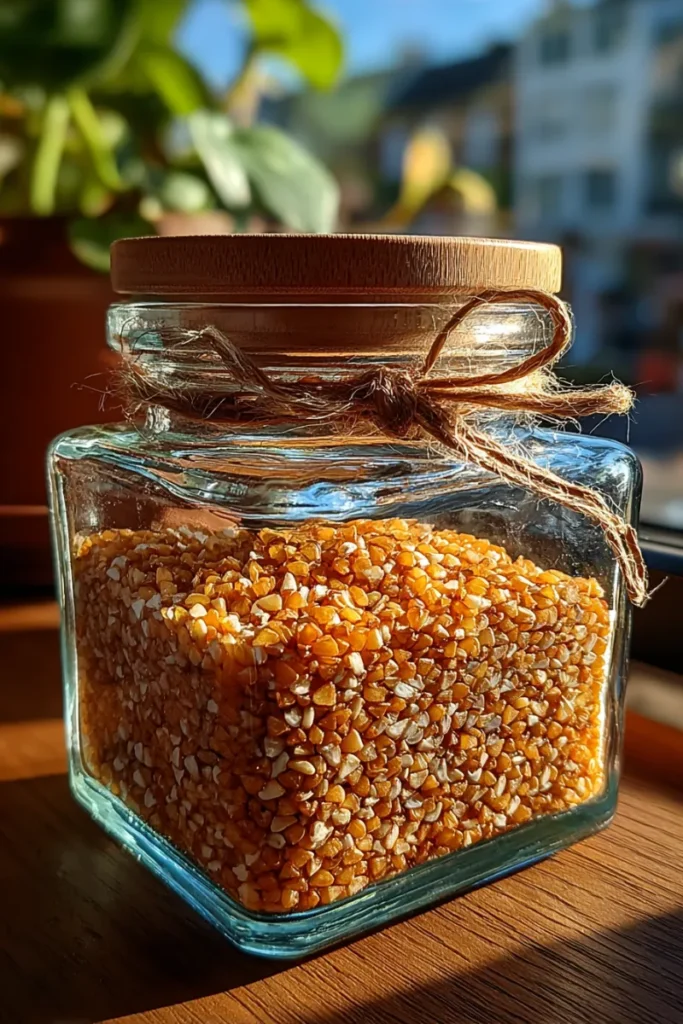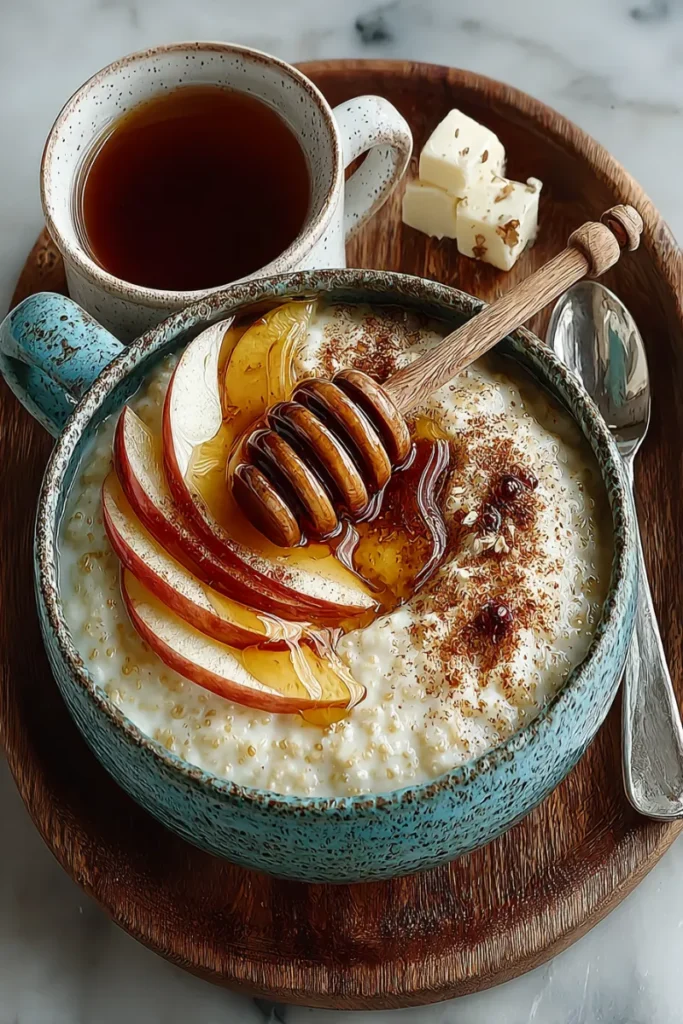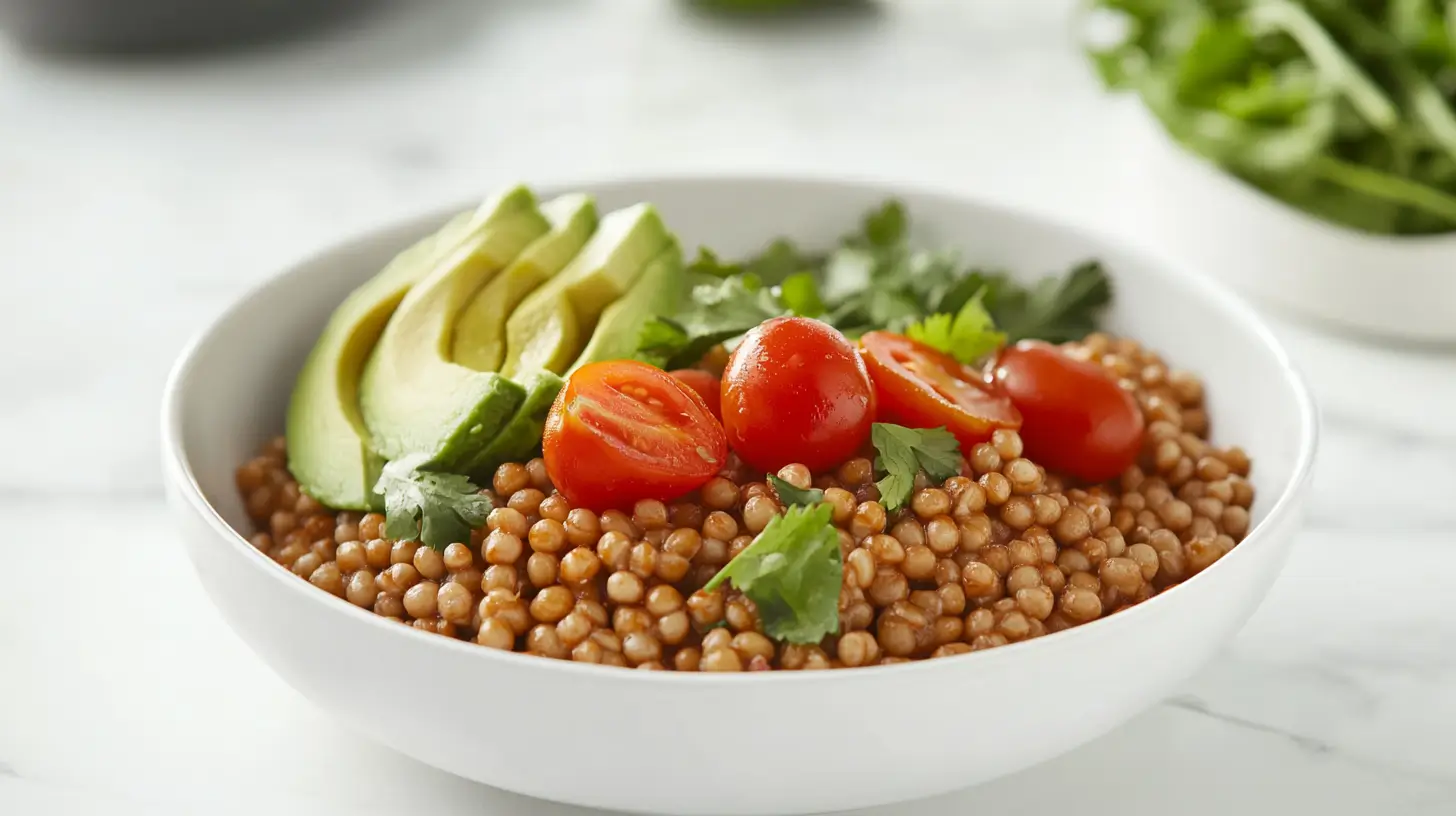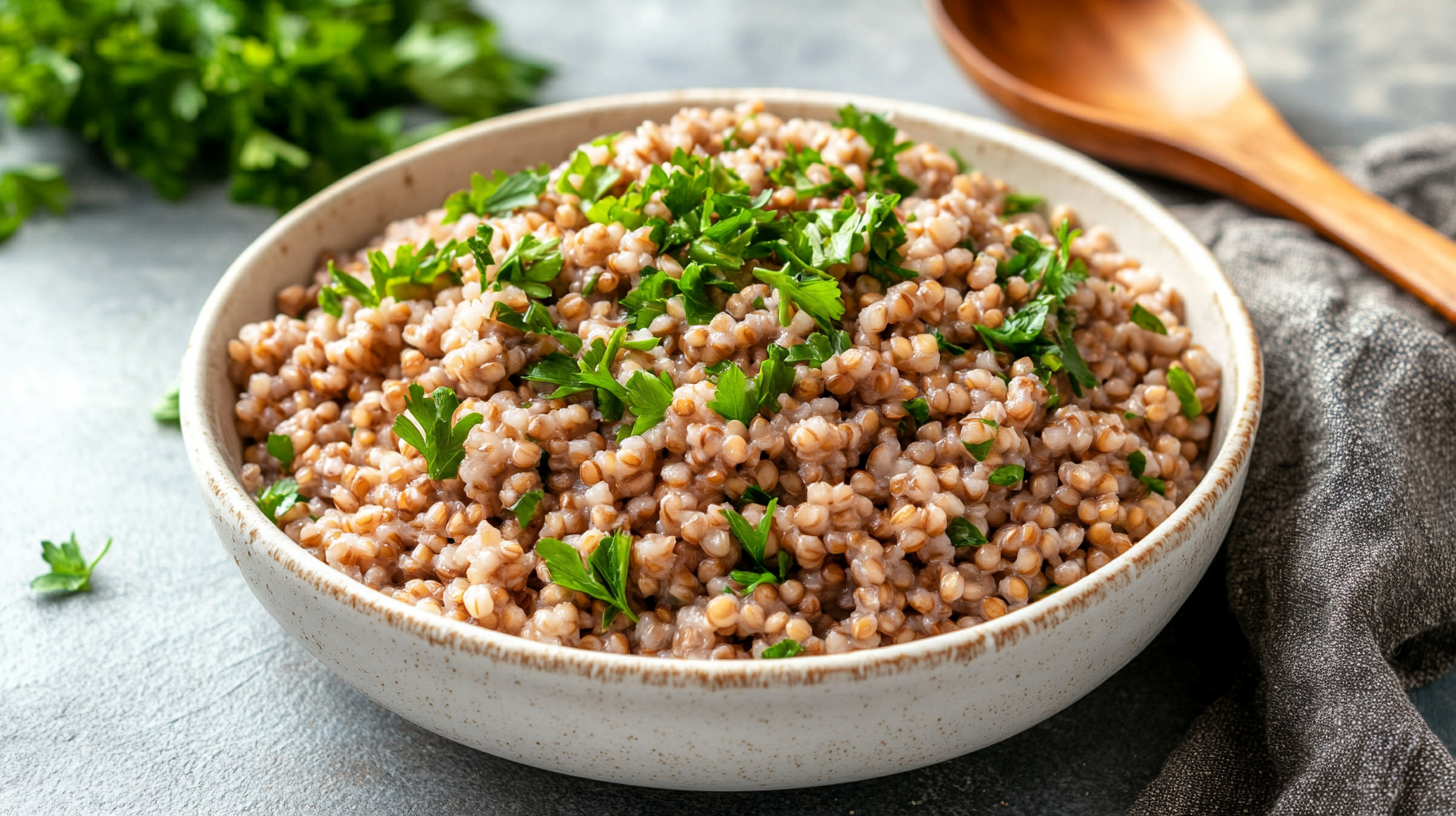Kasha gluten free diets are gaining massive traction among health-conscious eaters and those with gluten sensitivities. As people continue to ditch wheat and search for safer, whole-food substitutes, kasha has emerged as a surprising favorite. But what exactly is kasha? And more importantly—is kasha gluten free in every case?
This detailed guide takes a closer look at kasha gluten free benefits, origins, preparation methods, and potential risks for those with celiac disease or gluten intolerance. From cultural history to cooking techniques, we’ll cover everything you need to know to confidently enjoy kasha in your gluten-free lifestyle.
Want a deeper look at how kasha compares to buckwheat?
Check out what sets buckwheat and kasha apart.
Kasha Gluten Free Origins and What It Really Is
What Exactly is Kasha?
Kasha refers to roasted buckwheat groats, a gluten-free seed that behaves like a grain when cooked. Although many think of buckwheat as a cereal grain, it’s actually a pseudocereal, meaning it’s naturally gluten free and rich in nutrients. So if you’re trying to maintain a kasha gluten free meal plan, you’re in luck—when properly sourced, kasha fits the bill.
This hearty staple is especially popular in Eastern European cuisines and gaining ground in Western kitchens thanks to its nutty flavor, rich texture, and safe gluten-free profile. It’s also one of the easiest naturally gluten-free ingredients to incorporate into everything from breakfast bowls to savory mains.
When raw buckwheat groats are toasted, they become kasha. The roasting process not only deepens the flavor but also enhances the shelf life. However, it’s essential to make sure the kasha you buy is certified gluten free if you have sensitivities, as cross-contamination can occur during processing.
The Cultural Roots and Global Use of Kasha
Kasha has long been a beloved staple in Russian, Ukrainian, and Polish kitchens. It’s commonly served as porridge, used in dumplings, or cooked with mushrooms and onions for a savory dish. In Jewish cuisine, it stars in the classic comfort food kasha varnishkes, where it’s paired with bowtie noodles and caramelized onions.
Thanks to the modern rise in gluten-free and plant-based eating, this ancient dish is making a huge comeback. Its blend of earthy taste, satisfying texture, and kasha gluten free advantage makes it an ideal choice for health-conscious families, gluten-free cooks, and anyone seeking a delicious alternative to processed grains.
Up next: We’ll take a deeper dive into whether kasha is truly gluten free, how it’s processed, and what you need to watch out for if you’re gluten sensitive or have celiac disease.
Is Kasha Gluten Free? The Science Explained
Gluten 101: What It Is and Why It Matters
Gluten is a naturally occurring protein found in grains like wheat, barley, and rye. It gives dough its elasticity and structure. While gluten is safe for most, for those with celiac disease, non-celiac gluten sensitivity, or wheat allergies, even trace amounts can cause inflammation, fatigue, and long-term intestinal issues.
That’s why it’s important to explore gluten-free alternatives like pseudocereals—grain-like seeds that don’t contain gluten. Among these, buckwheat stands out for both its versatility and nutrition.
Why Kasha Is Naturally Gluten-Free
To answer the big question: yes, kasha is naturally gluten free—when it’s made from 100% roasted buckwheat groats. Despite the misleading name, buckwheat has no relation to wheat. It’s a seed, not a grain, which makes it ideal for gluten-free diets.
But here’s the key: for a kasha gluten free meal to be truly safe, the product must be certified gluten-free. Cross-contamination is a common risk in facilities that also process gluten-containing grains like wheat, rye, or barley. Always check the label and certification if you’re buying it for health or dietary reasons.
Many people are surprised to learn that buckwheat contains zero gluten, yet offers a satisfying texture and earthy flavor. It’s rich in fiber, magnesium, and antioxidants—making it both a healthy and practical base for gluten-free dishes.
To see how kasha fits into a lower-carb lifestyle, don’t miss our complete guide: Is Kasha Low in Carbs? Everything You Need to Know.
Next up: What’s the difference between buckwheat and kasha? Let’s clear up this common confusion once and for all.

Kasha vs Buckwheat – Clearing the Confusion
Are Buckwheat and Kasha the Same Thing?
While often used interchangeably, buckwheat and kasha are technically not the same. Buckwheat refers to the raw groats (hulled seeds) of the buckwheat plant. Kasha, by contrast, is what you get when those groats are toasted. This roasting process deepens the flavor, changes the color, and gives the grain a nutty, robust aroma.
In the world of kasha gluten free cooking, this distinction matters. Raw buckwheat has a milder flavor and softer texture when boiled. Toasted kasha becomes more hearty and chewy—perfect for warm dishes like porridges, pilafs, or savory breakfast bowls.
Whether you’re new to gluten-free living or just exploring grain alternatives, knowing the difference helps you make smarter choices. For anyone building a kasha gluten free diet, choosing the right form—raw or toasted—is key to flavor and function.
How Kasha is Processed Compared to Buckwheat
Kasha is made by roasting buckwheat groats at high heat—sometimes dry, sometimes with oil. This doesn’t add gluten, but contamination risks arise during processing.
If you’re following a kasha gluten free lifestyle, always look for certified gluten-free labels. This guarantees that your kasha hasn’t been processed in a facility that also handles wheat, barley, or rye.
Properly handled, kasha gluten free products retain all the nutritional value of buckwheat while becoming more flavorful and shelf-stable. Roasting shortens the cooking time and enhances taste, making it a favorite among quick meal preppers and gluten-free eaters.
The bottom line? If you’re eating gluten free and want variety, kasha gluten free meals are a hearty, satisfying addition to your rotation.
Health Benefits of Eating Gluten-Free Kasha
Nutritional Breakdown of Kasha
One of the biggest perks of a kasha gluten free diet is its nutritional value. Unlike many gluten-free options that rely on starch and sugar, kasha provides real, whole-food nutrition.
Here’s what you get in 1 cup of cooked kasha:
- 5–6 grams of protein
- 4–5 grams of fiber
- Complex carbohydrates
- Rich in magnesium, phosphorus, and zinc
- A source of rutin, an antioxidant supporting blood vessel health
Kasha is also one of the few plant-based foods that delivers all nine essential amino acids, making it a complete protein. This is especially important for vegans and vegetarians looking for non-gluten whole food options.
When you eat kasha gluten free recipes, you get more than just safe eating—you fuel your body with slow-burning carbs and digestive-friendly fiber.
Benefits for Gluten-Sensitive Individuals and Celiacs
For individuals managing celiac disease or gluten sensitivity, kasha gluten free foods offer a dependable and versatile alternative to wheat-based meals. They’re satisfying, nutrient-dense, and work in a wide range of dishes.
Top benefits of adding gluten-free kasha to your diet include:
- Improved digestion due to its high fiber content
- Balanced blood sugar from slow-release carbs
- Better nutrient intake compared to processed gluten-free products
- Meal versatility in breakfast, lunch, or dinner
If you’re looking to make it part of a low-carb, gluten-conscious plan, check out this guide: How to Make Kasha Low Carb
The takeaway? Kasha gluten free eating is more than a trend—it’s a smart, sustainable lifestyle for those who care about both flavor and health.
How to Cook Kasha the Gluten-Free Way
Cooking Methods: Stove, Oven, and Instant Pot
Cooking buckwheat kasha is simple, quick, and flexible. Whether you’re meal-prepping for the week or making a quick dinner side, there’s a method that fits your routine.
Stovetop Method (Classic Eastern European Style):
- Rinse 1 cup of toasted kasha in cold water
- Bring 2 cups of water or broth to a boil
- Add the rinsed kasha and a pinch of salt
- Reduce heat to low, cover, and simmer for 12–15 minutes
- Let it sit covered for 5 more minutes, then fluff with a fork
Instant Pot Method:
- Combine 1 cup kasha and 1.75 cups water
- Add salt and 1 tsp olive oil or butter (optional)
- Pressure cook on high for 4 minutes, then natural release for 10 minutes
Baking Method (for casseroles and gratins):
- Precook the kasha slightly (about 5 minutes on stove)
- Combine with your ingredients in a baking dish
- Bake covered at 350°F for 20–25 minutes
No matter which method you choose, always use certified gluten-free ingredients if you’re following a strict gluten-free diet. Even a bouillon cube or sauce could compromise your efforts if it’s not labeled safe.
Tips for Preventing Mushy Kasha
To keep your kasha light and fluffy—not sticky—follow these key tips:
- Use the right water ratio. Too much water will make the groats soggy.
- Rinse thoroughly. This removes excess starch that causes clumping.
- Toast it again (optional). Lightly dry-toast raw buckwheat groats before cooking to enhance texture.
- Avoid over-stirring. Stirring too much during cooking can break down the groats.
For more advanced prep, consider cooking in vegetable broth for added depth of flavor, or adding spices like cumin, garlic, or turmeric. Want to reduce carbs but still enjoy kasha? Learn more in our full guide: How to Make Kasha Low Carb
Tasty Gluten-Free Recipes Using Kasha
If you’re looking for easy and satisfying kasha gluten free meals, you’re in for a treat. From cozy breakfast bowls to flavorful dinner favorites, kasha is a versatile staple you can use all day long. Here are some tasty ways to bring it into your kitchen.
Breakfast Ideas with Kasha
1. Cinnamon Apple Kasha Porridge
A warm and naturally gluten-free breakfast rich in fiber and antioxidants.
Ingredients:
- ½ cup roasted kasha
- 1 cup almond milk (or other dairy-free milk)
- 1 diced apple
- 1 tsp cinnamon
- 1 tbsp maple syrup
Instructions:
- Boil almond milk, add kasha, apple, and cinnamon.
- Simmer for 10–12 minutes.
- Drizzle with syrup and serve warm.
Enjoy this as a classic kasha gluten free breakfast that keeps you full for hours.
2. Berry & Nut Kasha Power Bowl
Packed with protein and plant-based goodness, this is perfect for busy mornings.
Ingredients:
- ¾ cup cooked kasha
- Fresh berries (blueberries, raspberries)
- Chopped walnuts or almonds
- Chia seeds
- Drizzle of honey
Top your pre-cooked kasha with all ingredients and serve hot or cold.
Savory and Dinner Recipes Featuring Kasha
3. Kasha-Stuffed Bell Peppers
Use kasha instead of rice for a fiber-rich, gluten-free twist on this classic.
Ingredients:
- 1 cup cooked kasha
- 4 halved bell peppers
- 1 cup chopped spinach
- 1 onion, sautéed
- Garlic, olive oil, salt
Instructions:
- Mix kasha with sautéed spinach and onions.
- Stuff into peppers, drizzle with oil, and bake at 375°F for 25 minutes.
It’s one of the most filling kasha gluten free dinner recipes you’ll find.
4. Mushroom & Onion Kasha Pilaf
Inspired by traditional Eastern European cuisine, this dish is both comforting and healthy.
Ingredients:
- 1 cup kasha
- 2 cups gluten-free broth
- 1 chopped onion
- 1 cup sliced mushrooms
- Parsley for garnish
Cook onion and mushrooms, then add kasha and broth. Simmer until fluffy.
5. Gluten-Free Kasha Varnishkes
A reimagined version of a Jewish comfort food using gluten-free pasta.
Ingredients:
- 1 cup kasha
- 2 cups gluten-free bowtie pasta
- 1 large caramelized onion
Cook kasha and pasta, combine with onion, and season to taste.
Bonus Tip: Batch Cooking Kasha for the Week
You can cook a large batch of kasha and keep it in the fridge for up to 4 days. That way, you’re always a step away from a fast, nourishing kasha gluten free meal. Add it to soups, wraps, salads, or grain bowls.
For those watching carbs, make your dishes even lighter with this helpful guide:
How to Make Kasha Low Carb

Comparing Kasha with Other Gluten-Free Grains
When it comes to gluten-free grains, you’ve got plenty of options—but how does kasha gluten free nutrition stack up against other staples like quinoa, brown rice, and millet? Here’s a clear breakdown to help you decide which one fits your dietary goals best.
Kasha vs Quinoa
Nutritional Profile:
Quinoa is often praised for its complete protein content—and rightly so. But so is kasha. Both are excellent sources of essential amino acids, fiber, and minerals like magnesium and manganese.
Flavor & Texture:
Kasha has a nuttier, toastier flavor than quinoa, which is milder and slightly earthy. Kasha also holds up better in savory dishes, while quinoa is softer and fluffier.
Cooking Time:
Quinoa cooks in about 15 minutes, similar to kasha. Both are quick and convenient for meal prep.
Verdict:
If you’re already rotating quinoa into your diet, kasha gluten free recipes offer a great way to add variety and new flavor profiles.
Kasha vs Brown Rice
Nutritional Profile:
Brown rice has more carbohydrates and a slightly higher glycemic index. Kasha contains more fiber and protein per serving, making it a better option for blood sugar control.
Texture & Use:
Brown rice is chewy and bland unless seasoned well. Kasha is more robust and can be eaten plain thanks to its natural flavor.
Digestibility:
Kasha is easier on the stomach due to its smaller starch content and high fiber. Brown rice, while still healthy, can sometimes cause bloating in sensitive individuals.
Verdict:
If you’re seeking a kasha gluten free grain swap for rice, it’s a smart, nutrient-dense upgrade.
Kasha vs Millet
Nutritional Profile:
Millet is a great gluten-free option, but it lacks the complete protein profile kasha offers. It’s lower in fiber and generally less satisfying per serving.
Texture & Taste:
Millet is light and fluffy when cooked, similar to couscous. Kasha is more grounding and earthy.
Usage:
Millet is great for sweet dishes and lighter sides. Kasha fits better in hearty meals and one-bowl recipes.
Verdict:
Millet is versatile but less nutrient-dense. For those focused on a higher-protein, fiber-rich approach, kasha gluten free meals come out ahead.
Summary Table: Kasha vs Other Gluten-Free Grains
| Grain | Protein (g/cup) | Fiber (g/cup) | Cooking Time | Complete Protein? | Best Use |
|---|---|---|---|---|---|
| Kasha | 5–6 | 4–5 | 10–15 min | Yes | Pilafs, porridges, bowls |
| Quinoa | 8 | 5 | 15 min | Yes | Salads, bowls, casseroles |
| Brown Rice | 5–6 | 3–4 | 30–40 min | No | Stir-fries, side dishes |
| Millet | 6 | 2–3 | 20 min | No | Light porridge, sweet dishes |
Each of these grains has its place in a balanced diet, but when it comes to flavor, digestibility, and nutritional density, kasha gluten free options often outperform the rest.
Kasha in a Gluten-Free Diet Plan
Building a Weekly Meal Plan with Kasha
If you’re following a kasha gluten free lifestyle, integrating this powerhouse grain into your weekly meals will not only keep things interesting—it’ll also upgrade your nutrition. Whether you’re prepping meals for weight management, energy, or gut health, kasha delivers on all fronts.
It’s rich in fiber, packed with plant-based protein, and incredibly easy to prepare in bulk. Here’s a gluten-free meal plan using kasha as the featured ingredient throughout the week:
| Day | Meal Type | Kasha-Based Dish |
|---|---|---|
| Monday | Breakfast | Cinnamon apple kasha porridge |
| Tuesday | Lunch | Stuffed bell peppers with savory kasha filling |
| Wednesday | Dinner | Mushroom and onion kasha pilaf |
| Thursday | Snack | Cold kasha salad with lemon and parsley |
| Friday | Breakfast | Mixed berry kasha bowl with chia seeds |
Batch-cooking a few cups of kasha gluten free grain at the start of the week will give you endless combinations for lunchboxes, bowls, and wraps. It reheats well, pairs beautifully with fresh veggies or lean protein, and keeps you full longer than rice or quinoa.
For those with gluten sensitivity or celiac disease, this kind of planning can prevent cross-contamination. Be sure to choose certified gluten-free kasha to ensure every meal is safe and clean.
Who Should Eat Kasha and Who Should Avoid It
Who Should Eat It:
- Celiac patients or gluten-sensitive individuals: Kasha is naturally gluten free and easy to digest when sourced from safe facilities.
- Plant-based eaters: It’s one of the few plant foods offering complete protein.
- Active individuals: Rich in magnesium and B vitamins, kasha supports muscle recovery and energy metabolism.
- People managing blood sugar: The slow-releasing carbs in kasha gluten free dishes help keep glucose levels stable.
Who Should Avoid It:
- Those with buckwheat allergies: Rare but possible, these can cause mild to severe allergic reactions.
- Strict keto dieters: While lower in carbs than rice, kasha still isn’t keto-compatible.
Adding kasha gluten free recipes to your menu can also support weight management, heart health, and digestive regularity. It’s a nourishing grain option for anyone trying to avoid processed flours or sugar-loaded substitutes often found in gluten-free packaged foods.
Final Word
A well-balanced diet doesn’t have to be boring. By rotating in kasha gluten free meals, you’re not only avoiding gluten—you’re embracing a whole, nutritious, and flavorful grain that’s stood the test of time.
Where to Buy Gluten-Free Kasha + Storage Tips
Best Places to Buy Certified Gluten-Free Kasha
If you’re looking to stock up on kasha gluten free products, it’s important to buy from trusted brands that test and certify their foods. Even though buckwheat is naturally gluten free, it can be contaminated during processing or packaging unless handled carefully.
Here are some reputable online and in-store options:
- Bob’s Red Mill (look for their certified gluten-free roasted buckwheat groats)
- Arrowhead Mills
- Anthony’s Goods (gluten-free buckwheat groats, available online)
- Thrive Market
- Whole Foods / Sprouts Farmers Market (organic options often available in bulk bins)
Tip: Always double-check the label for a “Certified Gluten-Free” seal, especially if you have celiac disease or are highly sensitive. Avoid buying in bulk bins unless clearly marked and supervised.
Buying online gives you access to a broader selection of kasha gluten free brands, often at better prices. Look for customer reviews that mention taste, consistency, and texture if you’re trying a new brand.
How to Store Kasha for Maximum Freshness
Proper storage helps extend shelf life and preserve flavor, especially if you’re using kasha in multiple meals throughout the week.
Here’s how to store it right:
| Storage Type | Method | Shelf Life |
|---|---|---|
| Uncooked kasha | Store in airtight jar or sealed bag in a cool, dry place | Up to 12 months |
| Cooked kasha | Refrigerate in airtight container | Up to 4–5 days |
| Frozen kasha | Freeze in portioned freezer bags | Up to 2 months |
Avoid storing cooked kasha uncovered in the fridge, as it will dry out quickly and absorb odors from other foods. Always allow it to cool completely before sealing to prevent moisture buildup.
Using airtight containers, especially glass jars for uncooked kasha, helps preserve its nutty aroma and prevents pantry pests.
Bonus: Signs Your Kasha Has Gone Bad
- A rancid or sour smell
- Clumping or mold in cooked batches
- Bugs or moisture in dry groats
If in doubt, toss it out. Fresh, dry kasha should smell earthy and slightly toasted—not bitter or sour.
Whether you’re cooking in small batches or buying in bulk, having a dependable source of kasha gluten free grain ensures you’re always ready to create balanced, satisfying meals.
Conclusion
If you’re tired of the same old gluten-free grains, it’s time to give kasha gluten free meals a permanent place in your pantry. Naturally gluten-free, rich in nutrients, and incredibly versatile, kasha stands out as a go-to grain alternative for everything from breakfast bowls to dinner pilafs.
Whether you’re managing celiac disease, looking for plant-based protein, or simply expanding your culinary horizons, certified gluten-free kasha is a smart, satisfying choice. It’s flavorful, budget-friendly, and fits seamlessly into meal prep routines.
Now that you’ve learned what kasha is, how to cook it, and why it’s healthier than many traditional grains, you’re ready to build your own flavorful, balanced, and safe gluten-free meal plan.
Want more meal ideas? visit : How to Make Kasha Low Carb and start experimenting today.
FAQs
Does kasha contain gluten?
No, kasha does not contain gluten. It is made from toasted buckwheat groats, which are naturally gluten-free. However, it’s important to buy certified kasha gluten free products to avoid cross-contamination during processing.
What is the difference between kasha and buckwheat?
Buckwheat refers to the raw groats (hulled seeds), while kasha is the toasted version of those groats. The toasting process gives kasha a nuttier flavor and deeper color. Both are gluten-free, but kasha has a bolder taste and shorter cooking time.
Which grains have the least gluten?
The safest options for gluten-sensitive individuals include buckwheat (kasha), quinoa, millet, and rice. Among these, kasha gluten free dishes stand out for their complete protein and fiber-rich profile.
What is kasha made by?
Kasha is made by toasting hulled buckwheat groats. The process enhances its flavor, makes it quicker to cook, and improves its shelf life. It’s a popular grain alternative in Eastern European and gluten-free cooking.
Is kasha healthier than rice?
Yes, in many ways. Kasha has more protein and fiber than white rice and a lower glycemic index. It also contains essential minerals like magnesium, zinc, and iron, making it a more nutrient-dense option for those on a gluten-free diet.
Is kasha the same as farro?
No. Farro is a form of wheat and contains gluten, while kasha is made from buckwheat and is naturally gluten free. For anyone avoiding gluten, kasha gluten free meals are a safer and healthier alternative to farro-based recipes.
Follow us on Facebook and Pinterest for healthy recipes, smart cooking tips, and daily inspiration.





